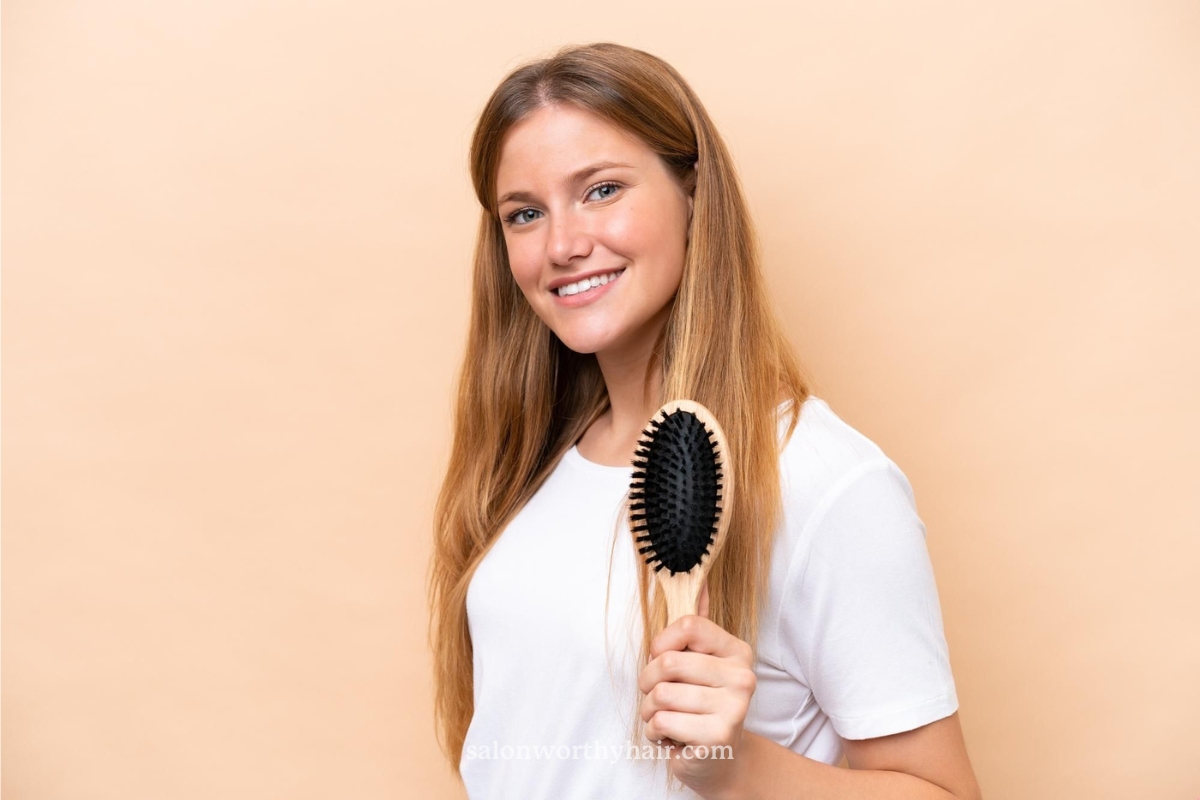Can You Brush Your Hair After a Keratin Treatment?
Updated on
This post may contain affiliate links. As an Amazon Associate, we may earn from qualifying purchases.

Yes, you can brush your hair after a keratin treatment once the treatment has fully bonded with your hair. It is important to give the keratin treatment time to set in before brushing; otherwise, you may risk damaging the treatment and causing your hair to become frizzy.
To get started, here are 3 easy rules to follow:
- Wait and allow the keratin treatment to bond in properly.
- Use the correct brush and comb.
- Do not brush to fix kinks and tangles.
With that said, let me explain everything you need to know about brushing keratin treated hair correctly and the potential mistakes to avoid.

When Can You Start Brushing Your Hair After a Keratin Treatment?
Wait at least 72 hours (3 days) after your keratin treatment to start brushing or combing your hair. This process is necessary to ensure the keratin treatment has had enough time to fully bond with the hair cuticles. During this period, your hair absorbs the keratin, setting it into its new, smoother structure. Brushing or combing within this time frame will disrupt the process and lead to less effective results.
When the waiting period is over, use the right brush or comb that won’t compromise the integrity of the keratin treatment.
What Type of Brush to Use on Keratin Treated Hair?
It’s best to use a gentle brush with soft bristles on keratin treated hair to prevent premature stripping of the keratin coating. A boar bristle brush is the best hairbrush to use on keratin treated hair combined with a wide tooth comb. You must avoid hair brushes with hard bristles, like metal bristles, as they will strip the keratin coating and make your hair frizzy.
Here are the reasons why the boar bristle brush and wide tooth comb are ideal:
- Boar Bristle Brush
- A boar bristle brush is made with natural hairs that closely mimic human hair in texture. The bristles are soft and flexible, which allows them to gently glide through the hair without pulling or snagging, reducing the risk of damage to the keratin treatment. Moreover, boar bristle brushes are excellent at distributing the natural oils from your scalp along the length of your hair. It helps keep the hair moisturized and shiny, enhancing the keratin treatment results. Boar bristle brushes come in different shapes and sizes, so you can choose one that suits your hair type and length.
- Wide-Tooth Comb
- A wide-tooth comb has wide spaces between the teeth, allowing the comb to detangle the hair without causing too much tension or pulling, which can harm the keratin layer. The ease of use makes a wide-tooth comb an excellent tool for initial detangling before you move on to the boar bristle brush. Get one that’s made of wood (not plastic), preferably sandalwood.
This combination approach helps to loosen tangles and knots in the hair to ensure a smooth and gentle brushing experience. It also reduces the risk of damage to the keratin treatment.
How to Brush Hair After a Keratin Treatment
The best way to brush your hair after a keratin treatment is to do it gently as the hair is more sensitive. Use your fingers or a wide tooth comb to gently loosen up tangles, knots, and kinks, then use the hairbrush to smooth out the hair.
Should You Brush on Wet Hair After Keratin Treatment?
Avoid brushing your hair when it’s wet. Wet hair is more fragile, elastic, and prone to tangles and breakage. Since hair is more sensitive after a keratin treatment, the risk for breakage can be potentially higher. If you have long or thick hair, try using a wide-tooth comb instead of a brush so that you do not pull on your tresses too hard. (more on this below)
Here’s are the general steps to follow when brushing hair after a keratin treatment:
- Wait 72 hours after the treatment:
Wait 72 hours before you wash or brush your hair. It allows the treatment to fully penetrate the hair shafts. Brushing too soon will cause the keratin coating to peel off. - Do not brush on wet hair:
Let your hair air dry naturally or use a blow dryer on low heat setting before you start to brush it. - Use the right hairbrush:
You must use a boar bristle brush with gentle and natural bristles. Avoid brushes with metal bristles or any type of hair brush that can cause friction. - Avoid tugging or pulling:
Never brush to fix tangles and knots. If you encounter a tangle, try to gently work it out with your fingers or a wide tooth comb. - Start from the bottom:
Using a wide-tooth comb to gently detangle your hair, starting from the ends and working your way up to the roots. Once your hair is tangle-free, use a boar bristle brush to smooth your hair out. - Use a lightweight oil or detangling spray:
You can apply a lightweight oil or a detangling spray to your hair before you brush it. This will help to soften the hair and make it easier to brush or comb through.
How to Comb Hair After Keratin Treatment
The same principles apply to combing the hair after a keratin treatment. However, because a wide tooth comb is better at untangling without ripping through the hair, it can also be used on wet hair.
So here are the general guides to follow when combing hair after keratin treatment:
- Wait for the appropriate amount of time.
- Use the right comb – A wide tooth comb.
- Start from the ends and work your way up – especially if you have long straight hair.
- Avoid forceful combing.
- Use a hair-detangling product to make your hair soft for combing.
Should You Use a Brush or Comb on Keratin Treated Hair?
Whether to use a brush or a comb on keratin treated hair often depends on a few factors, like your hair texture, the condition of your hair, whether wet or dry, and your preference.
Brush: A brush with soft, natural bristles can be a good choice for keratin treated hair when it’s dry. These brushes can help distribute natural oils from your scalp down the hair shaft, promoting shine and health. Remember to brush gently and start from the ends of your hair, working your way up to the roots to minimize breakage. Comb: A wide-tooth comb is often recommended for detangling keratin treated hair, especially when wet. This is because wet hair is more prone to breakage. A wide-tooth comb can gently detangle the hair without causing too much stress and potential damage.Regardless of whether you’re using a brush or a comb, make sure to handle your hair with care to maintain the benefits of the treatment and avoid unnecessary damage.
Mistakes to Avoid When Brushing Hair After Keratin Treatment
Here is a list of the common mistakes you should avoid when brushing your hair after a keratin treatment:
- Brushing too soon:Brushing hair too soon after a keratin treatment can disrupt the keratin that has been applied to the hair but hasn’t fully bonded yet. This can result in the keratin coating peeling off and the treatment becoming less effective.
- Brushing when hair is wet or damp:Brushing wet hair after a keratin treatment can lead to increased breakage, frizz, and split ends. Hair is at its most vulnerable when it’s wet. It becomes more elastic and can stretch when force is applied, such as when brushing.
- Brushing to fix tangles – do not brush to fix kinks:You must never use a hair brush to fix tangles and knots. The brush will rip through the hair instead of undoing the tangles. Use a wide tooth comb instead to work out the tangles starting from the ends and working your way up slowly.
- Rough Brushing:Rough brushing can cause undue stress and disrupt the keratin protein deposits on the hair shaft. Rough brushing also disrupts the hair cuticles, the outermost layer of the hair shafts where the keratin coating sits
- Using plastic or metal brush:Brushes with metal or hard plastic bristles can scratch the hair’s surface, damaging the cuticle. This can lead to frizz and dullness, counteracting the smoothing and shine-enhancing effects of the keratin treatment.
Consequences of Brushing Hair Incorrectly After Keratin Treatment
If you brush keratin treated hair incorrectly or overbrush, you may find yourself with the following problems:
- Hair breakage
- Reduced treatment longevity
- Increased frizz
- Split ends
So make sure you do not overdo it and follow the guidelines carefully.
Why You Need to Brush Your Hair After a Keratin Treatment
Brushing your hair after a keratin treatment is important for several reasons:
Ensures even distribution:Brushing your hair helps to distribute the keratin treatment evenly across all strands of your hair. The process ensures that every part of your hair benefits from the treatment, resulting in a more uniform and consistent look and feel.
Prevents tangling:Keratin treatments can sometimes cause the hair to become tangled, especially long hair. Regular brushing can help to prevent this by detangling the hair and making it easier to manage. It can also help to prevent damage caused by trying to untangle the hair forcefully.
Maintains treatment effect:Brushing helps maintain the effect of the Brazilian keratin or smoothing treatment for a longer time. By brushing, you ensure that the keratin proteins are absorbed into the hair shaft and not just on the surface.
Keeps hair soft and manageable:Brushing your hair after a keratin treatment can help keep your hair soft and manageable. The bristles of the brush can help to spread the natural oils from your scalp down the length of your hair, providing additional moisture and helping to maintain softness. This, combined with the smoothing effects of the keratin, can result in hair that is easier to style and manage.
Promotes shine:Regular brushing after a keratin treatment can also help increase your hair’s shine by smoothing the cuticles, reflecting more light and giving your hair a glossy look. It is an essential part of a good hair care routine. It helps to reduce frizz by aligning the hair strands and smoothing the hair cuticles, leading to a sleeker, more polished look.
Regular brushing also helps to distribute the hair’s natural oils or sebum from the scalp to the ends, acting as a natural conditioner that enhances the hair’s gloss and shine. This distribution of natural oils also contributes to maintaining the overall health of the hair, keeping it nourished and moisturized. This process can reduce frequent washing, as the oils help to naturally cleanse the hair and scalp.
Best Brush and Comb for Keratin Treated Hair
Denman Boar Bristle Brush
Wide Toothed Comb
About the Author
 Shehnaz Shirazi
Shehnaz ShiraziShehnaz Shirazi has been writing in the beauty and cosmetics industry for over 8 years, sharing her expansive hair care and beauty knowledge. Shehnaz researches and tests new hair care trends and publishes her insights here.

